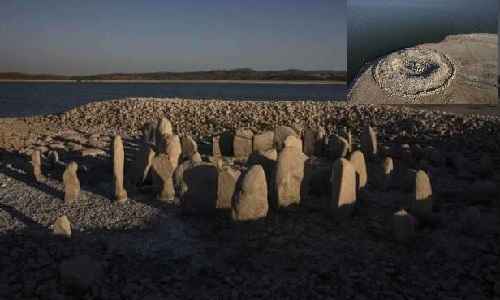The dry spell in Spain has seen the rise of Spanish Stonehenge from a dam in Caceres.
Many parts of Europe have been hit by the intense heat waves which, consequently, resulted in drought. In Spain, the mid-year has been severe, and individuals and guests are experiencing the intensity. Yet, one unexpected outcome of what is being viewed as the nation’s most horrendously terrible dry season in a decade has been the development of what is being named the ‘Spanish Stonehenge’ from a dam hit by low water levels.
The water levels in the Valdecanas supply in the focal region of Caceres have dropped to 28 % of the limit. The outcome: a circle of massive stones trusted to trace all the way back to 5000 BCE currently sits completely uncovered along the edge of the supply.
Formally known as the Dolmen of Guadalperal, the rise of the many gigantic stones has pleased archeologists who presently get an opportunity to concentrate on the ancient stone circle tracing all the way back to 5000 BCE. Making the most of this exceptional open door, specialists are dashing to focus on the circle before it is lowered once more. Said prehistorian Enrique Cedillo from Madrid’s Complutense University, “It’s a shock, it’s an uncommon chance to have the option to get to it.”
Also, Read | Severe Drought In Texas Park Uncovers 113-Million-Year-Old Dinosaur Tracks
Specialists trust the circle of around 150 rock stone monuments, called orthostats and ordinarily accepted to have been utilized as burial places, was an underlying arrangement with the late spring solstice – in view of the bent carvings on the greater part of the stones. A request has now been raised by the neighborhood verifiable and the travel industry relationship to attempt to move the stones to an exhibition hall or even to dry land.
The Dolmen of Guadelperal was founded in 1926 by German paleologist Hugo Obermaier. Being a sun-oriented sanctuary and maybe an internment enclave was thought. The remaining Roman parts on the site showed that it had been safeguarded from plundering. A settlement was likewise found close by that dated to a similar time as the tomb, and, in it, Obermaier tracked down houses, earthenware, factories, stones to hone tomahawks, and debris and charcoal stains.
The region was overflowed in 1963 in a rustic improvement project under the system of Francisco Franco, and it has become completely noticeable just multiple times since.

